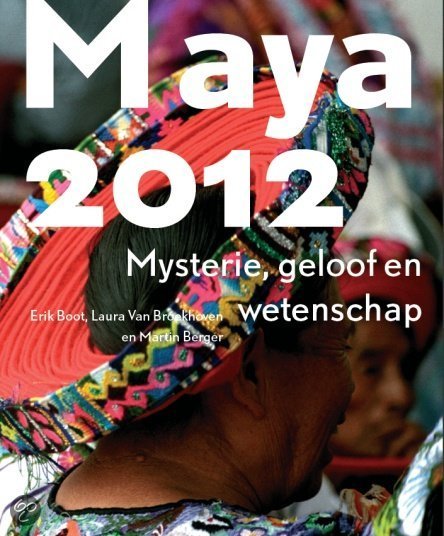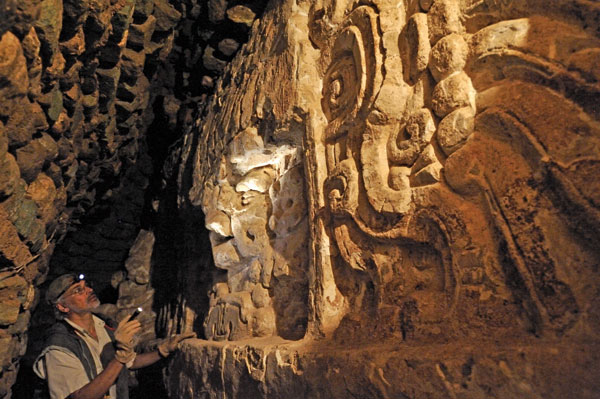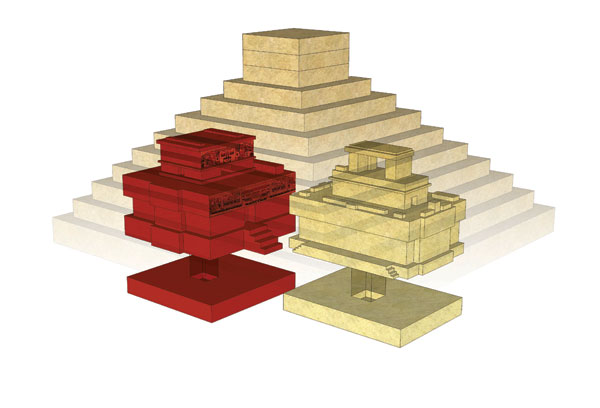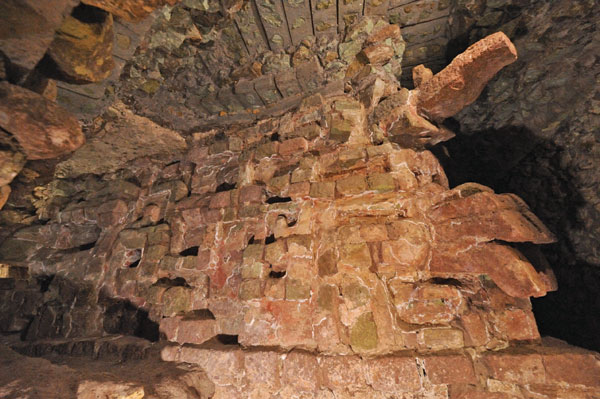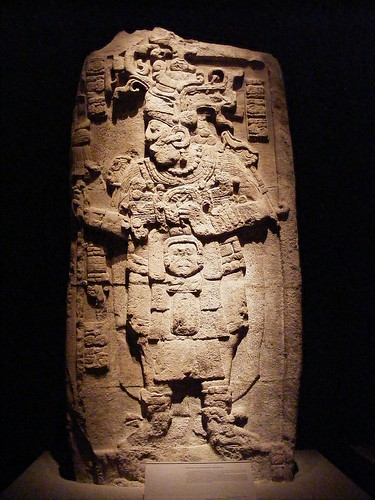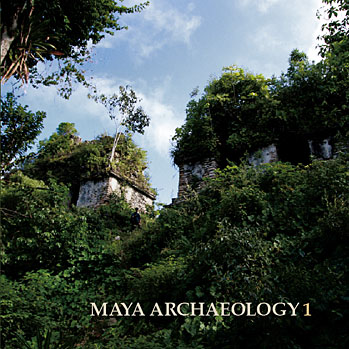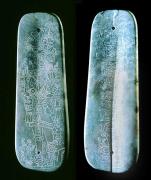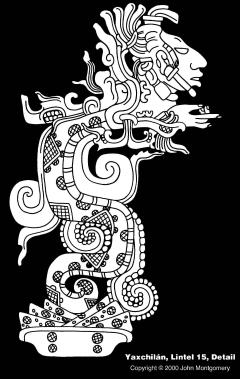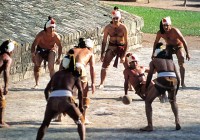Maya News Updates 2008, No. 11: The University of Texas in Austin Maya Meetings 2008
From February 25 to March 2, 2008, the Maya Meetings will be held at the University of Texas in Austin, this year's theme is "Copan Archaeology and History: New Finds and New Research." The workshops are tutored on February 25 - 28, with participant's presentations on the morning of February 29. On February 29 (afternoon) - March 2 a series of papers will be presented centered on the archaeology and history of Copan, Honduras.

The 2008 Specialized Workshop descriptions for Monday February 25 - Thursday February 28: Introduction to Maya Hieroglyphs led by Harri Kettunen (University of Helsinki) with Nick Carter (UT-Austin). Participants learn the basics of the deciphering Maya Hieroglyphs. Teams of participants work together, learning by doing and creating a finished text. Lectures and exercises introduce grammar, date structures, syntax, and structural analysis also. Enrollment is limited. No prior experience required .
Intermediate Maya Hieroglyphs led by outstanding epigraphers Erik Boot (Independent Scholar) and Alexandre Tokovinine (Harvard). More advanced participants continues to expand their knowledge of the intricacies of this writing system. New Material: Texts from Copan and Quirigua.
Los jeroglifos mayas: Niveles de Principiante e Intermedio. Experto Erik Velásquez García (Instituto de Investigaciones Estéticas, UNAM) guía a los participantes del taller en los fundamentos de la escritura y el pensamiento de los antiguos mayas del período clásico. Principiantes trabajarán textos de Palenque. ¡Nuevo! Al nuevo Nivel Intermedio se analizarán textos de Copán, en preparación para el Simposio. Taller y materiales didácticos en español , con tiempo para participar en los talleres en inglés.
Northern Yucatán Inscriptions and the Books of the Chilam Balam. Under the experienced guidance of Bruce Love (Independent Researcher, Juniper Hills, California) each student is encouraged to find his or her own project, and work individually or in small groups, investigating aspects of the Northern Maya culture of the Yucatan Peninsula, including monumental inscriptions, codices, and the newly added, very exciting field of Colonial-Period Maya literature, known as the Books of the Chilam Balam. Topics include hieroglyphic writing, iconography, religion, astronomy, history, and the calendar. Open to all levels, from beginner to advanced .
The Iconography of Maya Painted Vases led by Justin Kerr (Kerr Associates, NYC) and assisted by art historian Penny Steinbach (UT-Austin). Master photographer Kerr, one of the world's foremost authorities on Maya art, explores the exquisite genre of Maya painted vases. Kerr pioneered the rollout photographic technique and, with Barbara Kerr, they have produced "The Maya Vase Book: A Corpus of Rollout Photographs of Maya Painted Vessels," with 6 volumes released to date. While the vases are rich sources of texts for experienced glypher, the fluid, often narrative style invites the beginner into the ancient Maya world. Open to all levels, from beginner to advanced.
NEW ! Introduction to Maya Textiles. In an innovative extension of the Maya Meetings at Texas, explore the ancient, living tradition of Maya weaving. Curator and conservator Bárbara Knoke de Aranthoon (Museo Ixchel de Traje Indígena, Guatemala City), with fiber artist and educator Beatrice L. Thomas (Flatbed Press, Austin Community College), lead a unique workshop and studio class. Participants will learn backstrap weaving techniques, history of Mayan textiles, identification techniques, geographical contexts, ethnographical considerations of Mayan textiles (Allen J. Christenson, Brigham Young University), ancient depictions of textiles (David S. Stuart, UT-Austin), and additional techniques. Work with historic collections of Mesoamerican textiles from the Dept. of Art and Art History. Participants may exhibit the works they produce during the workshop at the Visual Arts Center, on Fri., 29 Feb. This workshop is designed for beginners, not experienced collectors or weavers. Enrollment is extremely limited. Additional costs apply for materials.
Problems in Mayan Linguistics & Epigraphy. Facilitated and led by Marc Zender (Harvard University), this seminar-style workshop features spirited cutting-edge exchanges among leading scholars of Maya writing in light of the latest information from decipherment and historical linguistics. The specific topic this year is "Mystery Glyphs and Problems in Decipherment" and Marc tells us he has a few surprises in store! Previous experience with Mayan languages and the hieroglyphic writing system are essential.
A special lecture will be presented on Wednesday, February 27
5:00 - 6:00 PM
Special Invited Lecture: Rudy Larios
Restoring Maya Architecture
Sponsored by the UT Mesoamerica Center, the Mexican Center of the Lozano Long Institute of Latin American Studies, and the UT School of Architecture Historic Preservation Program
5:00 - 6:00 PM
Special Invited Lecture: Rudy Larios
Restoring Maya Architecture
Sponsored by the UT Mesoamerica Center, the Mexican Center of the Lozano Long Institute of Latin American Studies, and the UT School of Architecture Historic Preservation Program
Further Schedule for: Friday, February 29 (afternoon)
3:30 - 5:00
David Stuart (University of Texas at Austin)
Copan’s History and Archaeology: An Overview
5:00 - 6:00
3:30 - 5:00
David Stuart (University of Texas at Austin)
Copan’s History and Archaeology: An Overview
5:00 - 6:00
Break
6:00 - 8:00
Keynote Lecture
Michael Coe (Yale University), In Search of the Snake-footed God: K'awiil and Tezcatlipoca
(Seating limited; registration required.)
8:00 - 9:30
Opening Reception and Photography Exhibit
Maya Light: Contemporary Photography of Central America
Photographs by Lesley Nowlin, Tahila Mintz, Lee Smith, Leigh Taylor
Location: Visual Arts Center (VAC), Department of Art and Art History
(next to Maya Meetings lecture hall)
Saturday, March 1
9:00 - 9:15
6:00 - 8:00
Keynote Lecture
Michael Coe (Yale University), In Search of the Snake-footed God: K'awiil and Tezcatlipoca
(Seating limited; registration required.)
8:00 - 9:30
Opening Reception and Photography Exhibit
Maya Light: Contemporary Photography of Central America
Photographs by Lesley Nowlin, Tahila Mintz, Lee Smith, Leigh Taylor
Location: Visual Arts Center (VAC), Department of Art and Art History
(next to Maya Meetings lecture hall)
Saturday, March 1
9:00 - 9:15
Welcome and Introductory Remarks
9:15 - 10:00
Dario A. Euraque (Gerente, Instituto Hondureño de Antropología e Historia)
Copan y Honduras: La Mayanizacion de un país: 1950 - 2000
10:00 - 10:45
Ricardo Agurcia Fasquelle (Associación Copan)
From Rosalila to Oropendola: The Evolution of Architectural Construction and Ornamentation under Temple 16 at Copan
10:45 - 11:00
9:15 - 10:00
Dario A. Euraque (Gerente, Instituto Hondureño de Antropología e Historia)
Copan y Honduras: La Mayanizacion de un país: 1950 - 2000
10:00 - 10:45
Ricardo Agurcia Fasquelle (Associación Copan)
From Rosalila to Oropendola: The Evolution of Architectural Construction and Ornamentation under Temple 16 at Copan
10:45 - 11:00
Coffee break
11:00 – 11:45
Simon Martin (University of Pennsylvania Museum)
The Iconography of the Altar of Stela M at Copan
11:45 – 12:15
11:00 – 11:45
Simon Martin (University of Pennsylvania Museum)
The Iconography of the Altar of Stela M at Copan
11:45 – 12:15
Discussion
12:15 - 2:00
12:15 - 2:00
Lunch
2:00 - 2:45
Fred Valdez, Jr. (University of Texas at Austin)
A Preclassic Temple at Río Azul, Guatemala
2:45 - 3:30
Marcello A. Canuto (Yale University) and
Ellen E. Bell (California State University, Stanislaus)
Like Ripples Breaking over a Wider Coastline: The Copan Kingdom of the 8th Century
3:30 - 3:45
2:00 - 2:45
Fred Valdez, Jr. (University of Texas at Austin)
A Preclassic Temple at Río Azul, Guatemala
2:45 - 3:30
Marcello A. Canuto (Yale University) and
Ellen E. Bell (California State University, Stanislaus)
Like Ripples Breaking over a Wider Coastline: The Copan Kingdom of the 8th Century
3:30 - 3:45
Coffee break
3:45 - 4:30
Stephen Houston (Brown University / Dumbarton Oaks)
The Hand of the Master: Evaluating the Production of Sculpture and Text at Copan, Honduras
4:30 - 5:00
3:45 - 4:30
Stephen Houston (Brown University / Dumbarton Oaks)
The Hand of the Master: Evaluating the Production of Sculpture and Text at Copan, Honduras
4:30 - 5:00
Discussion
5:00 - 5:30
5:00 - 5:30
Coffee break
5:30 - 7:30
Film Premiere: Breaking the Maya Code
Location: ART 1.102 lecture hall
(same auditorium as day-time lectures. This event is free and open to the public.
Priority seating for symposium registrants. Seating limited.)
Sunday, March 2
9:00 - 10:30
Special joint presentation:
William Fash (Harvard University), Barbara Fash (Harvard University) and David Stuart (University of Texas at Austin)
The Hieroglyphic Stairway: New Aspects of its Excavation, Documentation, Reconstruction and Decipherment
10:30- 10:45
5:30 - 7:30
Film Premiere: Breaking the Maya Code
Location: ART 1.102 lecture hall
(same auditorium as day-time lectures. This event is free and open to the public.
Priority seating for symposium registrants. Seating limited.)
Sunday, March 2
9:00 - 10:30
Special joint presentation:
William Fash (Harvard University), Barbara Fash (Harvard University) and David Stuart (University of Texas at Austin)
The Hieroglyphic Stairway: New Aspects of its Excavation, Documentation, Reconstruction and Decipherment
10:30- 10:45
Coffee break
10:45 - 11:45
Special joint presentation:
William Fash (Harvard University), Barbara Fash (Harvard University) and David Stuart (University of Texas at Austin)
The Hieroglyphic Stairway: New Aspects of its Excavation, Documentation, Reconstruction and Decipherment
11:45 - 12:00
10:45 - 11:45
Special joint presentation:
William Fash (Harvard University), Barbara Fash (Harvard University) and David Stuart (University of Texas at Austin)
The Hieroglyphic Stairway: New Aspects of its Excavation, Documentation, Reconstruction and Decipherment
11:45 - 12:00
Discussion
12:00 - 1:30
12:00 - 1:30
Lunch
1:30 - 2:15
Karl A. Taube (University of California, Riverside)
The City of Dawn: Copan and the Solar Symbolism of Mesoamerica
2:15 - 3:00
Allan Maca (Colgate University)
Tomb 1, El Bosque, Copan: Its Significance for Archaeology and Conservation
3:00 - 3:45
Loa Traxler (University of Pennsylvania Museum)
Enveloped in Red, Cradled in Shell: Ceremonial Deposits in the Copan Acropolis
4:00 - 4:30
1:30 - 2:15
Karl A. Taube (University of California, Riverside)
The City of Dawn: Copan and the Solar Symbolism of Mesoamerica
2:15 - 3:00
Allan Maca (Colgate University)
Tomb 1, El Bosque, Copan: Its Significance for Archaeology and Conservation
3:00 - 3:45
Loa Traxler (University of Pennsylvania Museum)
Enveloped in Red, Cradled in Shell: Ceremonial Deposits in the Copan Acropolis
4:00 - 4:30
Closing Remarks
For the most recent updates of this schedule and any further information on the 2008 Maya Meetings, please turn to The Maya Meetings, UT Austin).
From tomorrow February 23 to March 5 I will be in Austin, updates for my blogs Maya News Updates and/or Ancient MesoAmerica News Updates may be delayed to after my return to the Netherlands.
Erik Boot




